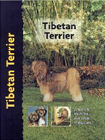
Tibetan Terrier
Tibetan Terriers are like a taller version of Lhasa Apsos, and, like Lhasa Apsos, they were kept in Tibetan monasteries. They are not really terriers, having been developed as watchdogs, companions, and even herders, rather than dogs that went underground to hunt. Tibetan Terriers tend to be independent and fun loving.
They benefit from early training, and consistency about house rules from puppyhood. This breed likes the company of their owners, tending to bond strongly, and not being happy at being left alone for long periods. They can be a little barky on first meeting someone new, but well-socialized individuals soon accept people introduced to them by their owners, and usually get on very well with children.
Tibetan Terriers like to play, and tend to get on well with anyone who offers them a ball game, though they aren't natural retrievers, enjoying the chase after the ball more than bringing it back. They need daily off-leash active play, or they tend to become barky from boredom. Tibetan Terriers that have enough exercise aren't especially barky most of the time, though their barks can be quite loud, so they are good watchdogs. They usually get on well with other dogs.
Tibetan Terriers do need a lot of grooming, especially if their coat is untrimmed, though, like Lhasa Apsos, they do benefit from a trim, which means that they need far less grooming, collect mud less, and can see properly! They don't shed much when groomed and trimmed regularly. Common health problems include eye and hip trouble, and flea allergies, but generally, this is a healthy, long-lived breed.
Juliette Cunliffe has written a good introduction to the breed, with a clear account of the breed's history and character, as well as providing helpful advice on general care.



